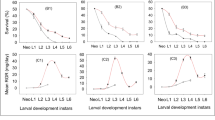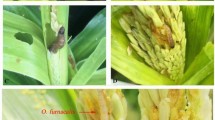Abstract
The fall armyworm, Spodoptera frugiperda (J. E. Smith) and the corn earworm, Helicoverpa zea (Boddie) are among the main pests of maize. Both species exhibit cannibalistic behavior and quite often share the same feeding guild in maize (maize ears), which can result in several interspecific and intraspecific interactions. Paired interaction scenarios of intraspecific and interspecific larvae were assessed in arenas in the presence and absence of food to characterize movements resulting from interactions of these insects. There was a difference in the frequency of behavioral movements in all the interactions, except for S. frugiperda in the presence of food. Head touching and recoiling were the predominant movements in most of the interaction scenarios. Spodoptera frugiperda exhibited a predominance of defensive movements when competing against H. zea in the same instars. Cannibalism and predation occurred frequently in interactions involving 6th instar of H. zea against opponents in 4th instar. Larvae of H. zea show a higher aggressive movement than S. frugiperda. The larvae of S. frugiperda take advantage during the interactions, although they present more defensive movements compared to H. zea. This study provides relevant information regarding the interaction of these species and intraguild interaction, which might influence the population dynamics and the competitive displacement of pest species that share the same ecological niche.




Similar content being viewed by others
References
Alabi T, Patiny S, Verheggen F, Francis F, Haubruge E (2009) Origine et évolution du cannibalisme dans les populations animals: pourquoi manger son semblable? Biotechnol Agron Soc Environ 13:409–425
Andow DA, Farias JR, Horikoshi RJ, Bernardi ARB, Nascimento ARB, Omoto C (2015) Dynamics of cannibalism in equal-aged cohorts of Spodoptera frugiperda. Ecol Entomol 40:229–236. doi:10.1111/een.12178
Archer TL, Bynum ED Jr (1994) Corn earworm (Lepidoptera: Noctuidae) biology on food corn on the high plains. J Econ Entomol 23:343–348. doi:10.1093/ee/23.2.343
Arnott G, Elwood RW (2009) Assessment of fighting ability in animal contests. Anim Behav 77:991–1004. doi:10.1016/j.anbehav.2009.02.010
Barros EM, Torres JB, Bueno AF (2010) Oviposition, development, and reproduction of Spodoptera frugiperda (J.E. Smith) (Lepidoptera: Noctuidae) fed on different hosts of economic importance. Neotrop Entomol 39:996–1001. doi:10.1590/S1519-566X2010000600023
Benelli G (2015) Should I fight or should I flight? How studying insect aggression can help integrated pest management. Pest Manag Sci 71:885–892. doi:10.1002/ps.3974
Bentivenha JPF, Baldin ELL, Hunt TE, Paula-Moraes SV, Blankenship EE (2016) Intraguild competition of three noctuid maize pests. Environ Entomol. doi:10.1093/ee/nvw068
Binning RR, Coats J, Kong X, Hellmich RL (2014) Susceptibility and aversion of Spodoptera frugiperda (Lepidoptera: Noctuidae) to Cry1F Bt maize and considerations for insect resistance management. J Econ Entomol 107:368–374. doi:10.1603/EC13352
Boyd MB, Daniels JC, Austin GT (2008) Predaceous behavior by Helicoverpa zea (Boddie) (Lepidoptera: Noctuidae: Heliothinae). J Insect Behav 21:143–146. doi:10.1007/s10905-007-9113-0
Briffa M (2008) Decisions during fights in the house cricket, Acheta domesticus: mutual or self assessment of energy, weapons and size? Anim Behav 75:1053–1062. doi:10.1016/j.anbehav.2007.08.016
Brown WD, Smith AT, Moskalik B, Gabriel J (2006) Aggressive contests in house crickets: size, motivation and the information content of aggressive songs. Anim Behav 72:225–233. doi:10.1016/j.anbehav.2006.01.012
Burkness EC, Dively GP, Patton T, Morey AC, Hutchison WD (2010) Novel Vip3A Bacillus thuringiensis (Bt) maize approaches high dose efficacy against Helicoverpa zea (Lepidoptera: Noctuidae) under field conditions: implications for resistance management. GM Crops 1:337–343. doi:10.4161/gmcr.1.5.14765
Burkness EC, O’Rourke PK, Hutchison WD (2011) Cross-pollination of nontransgenic corn ears with transgenic Bt corn: efficacy against lepidopteran pests and implications for resistance management. J Econ Entomol 104:1476–1479. doi:10.1603/EC11081
Burkness EC, Cira TM, Moser SE, Hutchison WD (2015) Bt maize seed mixtures for Helicoverpa zea (Lepidoptera: Noctuidae): larval movement, development, and survival on non-transgenic maize. J Econ Entomol. doi:10.1093/jee/tov253
Capinera JL (2005) Featured creatures Helicoverpa zea corn earworm. University of Florida. Institute of Food and Agricultural Sciences, Department of Entomology and Nematology, Florida Department of Agricultural and Consumer Services. Department of Plant Industry. http://creatures.ifas.ufl.edu/veg/corn_earworm.htm#life. Accessed on 8 Oct, 2006
Chapman JW, Williams T, Escribano A, Caballero P, Cave RD, Goulson D (1999a) Fitness consequences of cannibalism in the fall armyworm, Spodoptera frugiperda. Behav Ecol 10:298–303. doi:10.1093/beheco/10.3.298
Chapman JW, Williams T, Escribano A, Caballero P, Cave RD, Goulson D (1999b) Age-related cannibalism and horizontal transmission of a nuclear polyhedrosis virus in larval Spodoptera frugiperda. Ecol Entomol 24:268–275. doi:10.1046/j.1365-2311.1999.00224.x
Chapman JW, Williams T, Martínez AM, Cisneros J, Caballero P, Cave RD, Goulson D (2000) Does cannibalism in Spodoptera frugiperda (Lepidoptera: Noctuidae) reduce the risk of predation? Behav Ecol Sociobiol 48:321–327. doi:10.1007/s002650000237
Chilcutt CF (2006) Cannibalism of Helicoverpa zea (Lepidoptera: Noctuidae) from Bacillus thuringiensis (Bt) transgenic corn versus non-Bt corn. J Econ Entomol 99:728–732. doi:10.1603/0022-0493-99.3.728
Chilcutt CF, Odvody GN, Correa JC, Remmers J (2007) Effects of Bacillus thuringiensis transgenic corn on corn earworm and fall armyworm (Lepidoptera: Noctuidae) densities. J Econ Entomol 100:327–334. doi:10.1603/0022-0493(2007)100[327:EOBTTC]2.0.CO;2
Cruz I, Turpin FT (1983) Yield impact of larval infestation of the fall armyworm Spodoptera frugiperda (J.E.Smith) to mid-whorl growth stage of corn. J Econ Entomol 76:1052–1054. doi:10.1093/jee/76.5.1052
Cruz I, Figueiredo MLC, Oliveira A, Vasconcelos CA (1999) Damage of Spodoptera frugiperda (Smith) in different maize genotypes cultivated in soil under three levels of aluminum saturation. Int J Pest Manag 45:293–296. doi:10.1080/096708799227707
Cunningham JP, Zalucki MP (2014) Understanding Heliothine (Lepidoptera: Heliothinae) pests: what is a host plant? J Econ Entomol 107:881–896. doi:10.1603/EC14036
Da Silva CSB, Parra JRP (2013) New method for rearing Spodoptera frugiperda in laboratory shows that larval cannibalism is not obligatory. Rev Bras Entomol 57:347–349. doi:10.1590/S0085-56262013005000029
Dawkins R (1976) The selfish gene. Oxford University Press, Oxford
Dial CI, Adler PH (1990) Larval behavior and cannibalism in Heliothis zea (Lepidoptera: Noctuidae). Ann Entomol Soc Am 83:258–263. doi:10.1093/aesa/83.2.258
Dodson G (1986) Lek mating system and large male aggressive advantage in a gall-forming tephritid fly (Diptera: Tephritidae). Ethology 72:99–108
Dorhout DL, Rice ME (2010) Intraguild competition and enhanced survival of western bean cutworm (Lepidoptera: Noctuidae) on transgenic Cry1Ab (MON810) Bacillus thuringiensis corn. J Econ Entomol 103:54–62. doi:10.1603/EC09247
Eickwort KR (1973) Cannibalism and kin selection in Labidomera clivicollis (Coleoptera: Chrysomelidae). Am Nat 107:452–453
Elgar M, Crespi J (1992) Cannibalism: ecology and evolution among diverse taxa. Oxford University Press, Oxford
Farias JR, Andow DA, Horikoshi RJ, Sorgatto RJ, dos Santos AC, Omoto C (2015) Dominance of Cry1F resistance in Spodoptera frugiperda (Lepidoptera: Noctuidae) on TC1507 Bt maize in Brazil. Pest Manag Sci. doi:10.1002/ps.4077
Fox LR (1975) Cannibalism in natural populations. Annu Rev Ecol Syst 6:87–106. doi:10.1146/annurev.es.06.110175.000511
Gould F, Holtzman G, Rabb RL, Smith M (1980) Genetic-variation in predatory and cannibalistic tendencies of Heliothis virescens (Lepidoptera, Noctuidae) strains. Ann Entomol Soc Am 73:243–250. doi:10.1093/aesa/73.3.243243-250
Goussain MM, Moraes JC, Carvalho JG, Nogueira NL, Rossi ML (2002) Effect of silicon application on corn plants upon the biological development of the fall armyworm Spodoptera frugiperda (J.E.Smith) (Lepidoptera: Noctuidae). Neotrop Entomol 31:305–310. doi:10.1590/S1519-566X2002000200019
Hardwick DF (1965) The corn earworm complex. Mem Ent Soc Canada 40:1–247. doi:10.4039/entm9740fv
Horner TA, Dively GP (2003) Effect of MON810 Bt field corn on Helicoverpa zea (Lepidoptera: Noctuidae) cannibalism and its implications to resistance development. J Econ Entomol 96:931–934. doi:10.1603/0022-0493-96.3.931
Horner TA, Dively GP, Herbert DA (2003) Development, survival and fitness performance of Helicoverpa zea (Lepidoptera: Noctuidae) in MON-810 Bt field corn. J Econ Entomol 96:914–924. doi:10.1093/jee/96.3.914
Kakimoto T, Fujisaki K, Miyatake T (2003) Egg laying preference, larval dispersion, and cannibalism in Helicoverpa armigera (Lepidoptera: Noctuidae). Ann Entomol Soc Am 96:793–798. doi:10.1603/0013-8746(2003)096[0793:ELPLDA]2.0.CO;2
Kirkpatrick TW (1957) Insect life in the tropics. Longmans, London
Malaquias JB, Omoto C, Ramalho FS, Wesley WAC, Silveira RF (2015) Bt cotton and the predator Podisus nigrispinus (Dallas) (Heteroptera: Pentatomidae) in the management of Spodoptera frugiperda (J.E. Smith) (Lepidoptera: Noctuidae) resistance to lambda-cyhalothrin. J Pest Sci 88:57–63. doi:10.1007/s10340-014-0585-3
Napal GND, Palacios SM (2015) Bioinsecticidal effect of the flavonoids pinocembrin and quercentin against Spodoptera frugiperda. J Pest Sci 88:629–635. doi:10.107/s10340-014-0641-z
Pannuti LER, Baldin ELL, Hunt TE, Paula-Moraes SV (2016) On-plant larval movement and feeding behavior of fall armyworm (Lepidoptera: Noctuidae) on reproductive corn stages. Environ Entomol 45:192–200. doi:10.1093/ee/nvv159
Pfennig DW, Reeve HK, Sherman PW (1993) Kin recognition and cannibalism in spadefoot toad tadpoles. Anim Behav 46:87–94. doi:10.1006/anbe.1993.1164
Pierce NE (1995) Predatory and parasitic Lepidoptera: carnivores living on plants. J Lepidopt Soc 49:412–453
Polis GA (1981) The evolution and dynamics of intraspecific predation. Annu Rev Ecol Evol Syst 12:225–251. doi:10.1146/annurev.es.12.110181.001301
Prasifka PL, Hellmich RL, Prasifka JR, Lewis LC (2007) Effects of Cry1Ab-Expressing corn anthers on the movement of monarch butterfly larvae. Environ Entomol 36:228–233. doi:10.1603/0046-225X-33.4.1109
Reynolds SE (1980) Integration of behaviour and physiology in ecdysis. Adv Insect Physiol 15:475–595. doi:10.1016/S0065-2806(08)60144-7
Ritchie SW, Hanway JJ, Benson GO (1993) How a corn plant develops. Special Report Number 48. Iowa State University of Science and Technology, Cooperative Extension Service, Ames, IA
Sarmento RA, Aguiar RWS, Aguiar RASS, Vieira SMJ, Oliveira HG, Holtz AM (2002) Revisão da biologia, ocorrência e controle de Spodoptera frugiperda (Lepidoptera, Noctuidae) em milho no Brasil. Biosci J 18:41–48
SAS Institute (2001) SAS/STAT 9.3. SAS Institute, Cary
Shelly TE (1999) Defense of oviposition sites by female oriental fruit flies (Diptera: Tephritidae). Fla Entomol 82:339–346. doi:10.2307/3496587
Siebert MW, Nolting SP, Hendrix W, Dhavala S, Craig C, Leonard BR, Stewart SD, All J, Musser FR, Buntin GD, Samuel L (2012) Evaluation of corn hybrids expressing Cry1F, Cry1A.105, Cry2Ab2, Cry34Ab1/Cry35Ab1, and Cry3Bb1 against southern United States insect pests. J Econ Entomol 105:1825–1834. doi:10.1603/EC12155
Stevenson PA, Schildberger K (2013) Mechanisms of experience dependent control of aggression in crickets. Curr Opin Neurobiol 23:318–323. doi:10.1016/j.conb.2013.03.002
Stinner RE, Rabb RL, Bradley Jr JR (1977) Natural factors operating in the population dynamics of Heliothis zea in North Carolina In: Proceedings, 15th International Congress of Entomology, Entomological Society of America, College Park, pp 622–642.
Wise DH (2006) Cannibalism, food limitation, intraspecific competition, and the regulation of spider populations. Annu Rev Entomol 51:441–465. doi:10.1146/annurev.ento.51.110104.150947
Acknowledgments
We thank Ana Maria Velez and James Kalisch (University of Nebraska) for the technical support.
Funding
Funding for research was provided by the Coordination for the Improvement of Higher Education Personnel (99999.002564/2014-09).
Author information
Authors and Affiliations
Corresponding author
Ethics declarations
Conflict of Interest
All authors declare that they have no conflict of interest.
Ethical Approval
This article does not contain any studies with human or animal performed by any of the authors.
Additional information
Communicated by A. R. Horowitz.
Rights and permissions
About this article
Cite this article
Bentivenha, J.P.F., Baldin, E.L.L., Montezano, D.G. et al. Attack and defense movements involved in the interaction of Spodoptera frugiperda and Helicoverpa zea (Lepidoptera: Noctuidae). J Pest Sci 90, 433–445 (2017). https://doi.org/10.1007/s10340-016-0802-3
Received:
Revised:
Accepted:
Published:
Issue Date:
DOI: https://doi.org/10.1007/s10340-016-0802-3




